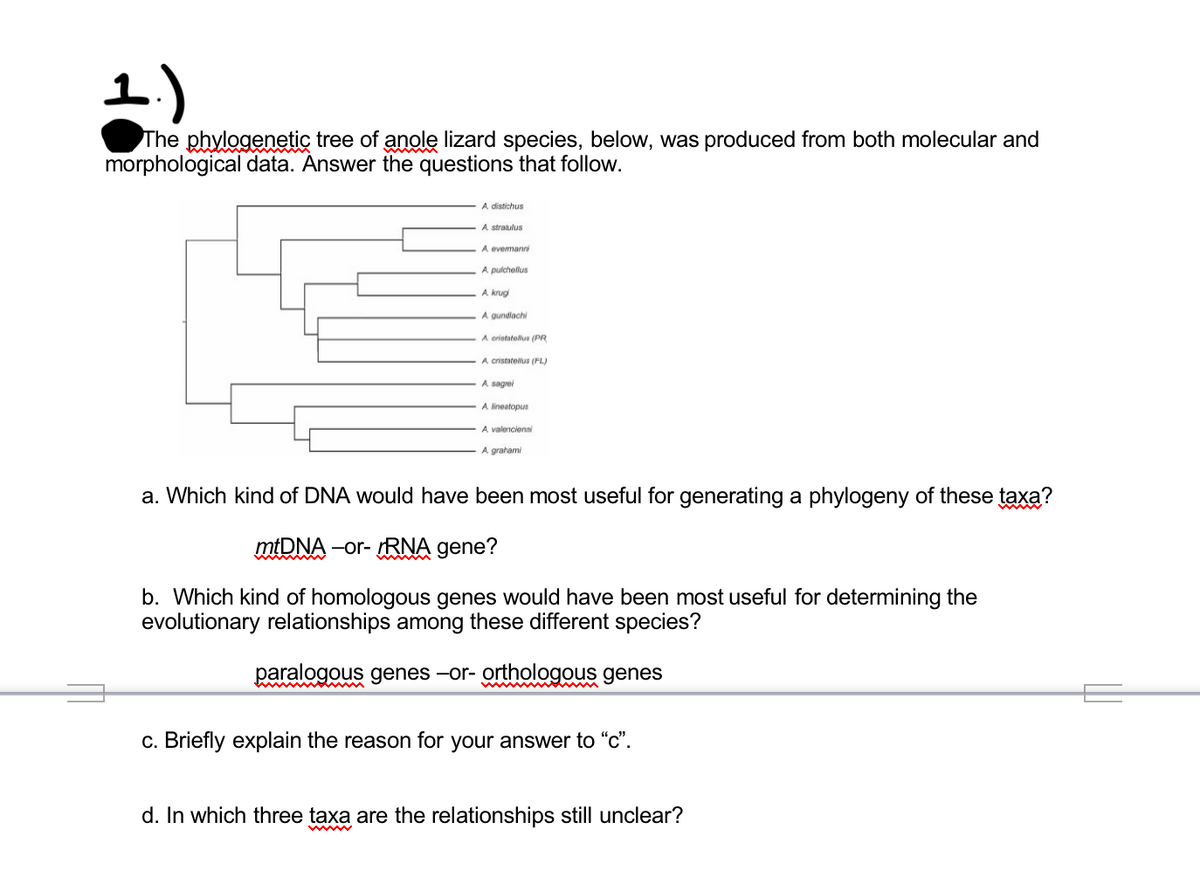The phylogenetic tree of anole lizard species, below, was produced from both molecular and morphological data. Answer the questions that follow. A distichus A straulus A evemanni A pulchellus A kug A gundlachi A eristatell (PR A cristatelus (PL) A sagei A lineatopus A valenciensi A gratami a. Which kind of DNA would have been most useful for generating a phylogeny of these taxa? mtDNA -or- RNA gene? b. Which kind of homologous genes would have been most useful for determining the evolutionary relationships among these different species? paralogous genes -or- orthologous genes wwwM c. Briefly explain the reason for your answer to “".
The phylogenetic tree of anole lizard species, below, was produced from both molecular and morphological data. Answer the questions that follow. A distichus A straulus A evemanni A pulchellus A kug A gundlachi A eristatell (PR A cristatelus (PL) A sagei A lineatopus A valenciensi A gratami a. Which kind of DNA would have been most useful for generating a phylogeny of these taxa? mtDNA -or- RNA gene? b. Which kind of homologous genes would have been most useful for determining the evolutionary relationships among these different species? paralogous genes -or- orthologous genes wwwM c. Briefly explain the reason for your answer to “".
Biology: The Dynamic Science (MindTap Course List)
4th Edition
ISBN:9781305389892
Author:Peter J. Russell, Paul E. Hertz, Beverly McMillan
Publisher:Peter J. Russell, Paul E. Hertz, Beverly McMillan
Chapter24: Systematics And Phylogenetics: Revealing The Tree Of Life
Section: Chapter Questions
Problem 1ITD: The phylogenetic tree for 12 cat species (Felidae) reproduced at right was assembled from molecular...
Related questions
Question

Transcribed Image Text:1)
The phylogenetiç tree of anole lizard species, below, was produced from both molecular and
morphological data. Answer the questions that follow.
A distichus
A straulus
A evemanni
A pulchellus
A krug
A gundlachi
A cristatollua (PR
A cristatellus (FL)
A sagrel
A lineatopus
A valencienni
A grahami
a. Which kind of DNA would have been most useful for generating a phylogeny of these taxa?
mtDNA -or- RNA gene?
b. Which kind of homologous genes would have been most useful for determining the
evolutionary relationships among these different species?
paralogous genes -or- orthologous genes
c. Briefly explain the reason for your answer to "c".
d. In which three taxa are the relationships still unclear?
www
Expert Solution
This question has been solved!
Explore an expertly crafted, step-by-step solution for a thorough understanding of key concepts.
Step by step
Solved in 4 steps

Knowledge Booster
Learn more about
Need a deep-dive on the concept behind this application? Look no further. Learn more about this topic, biology and related others by exploring similar questions and additional content below.Recommended textbooks for you

Biology: The Dynamic Science (MindTap Course List)
Biology
ISBN:
9781305389892
Author:
Peter J. Russell, Paul E. Hertz, Beverly McMillan
Publisher:
Cengage Learning

Biology: The Dynamic Science (MindTap Course List)
Biology
ISBN:
9781305389892
Author:
Peter J. Russell, Paul E. Hertz, Beverly McMillan
Publisher:
Cengage Learning